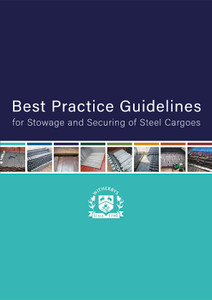
CDI Best Practice Recommendations Regarding the use of Nitrogen. (eBook)
This publication is a guide to best practice recommendations for the use of nitrogen on board chemical tankers.
This guide to the use of nitrogen on board chemical tankers outline best practice recommendations and covers topics including:
- Hazard identification
- nitrogen operations (including entry into enclosed spaces, purging/inerting and tank cleaning)
- vessels with a nitrogen generator
- vessels without a nitrogen generator
- miscellaneous operations.
The purpose of this document is to provide the chemical industry best practice recommendation for consideration during the inerting process and future revisions of legislation and industry guidelines. In addition, this document is directed towards any party involved with tank ships carrying chemicals, including, but not limited to, vessel personnel, shore personnel, surveyors, inspectors and charterers. This document will be periodically reviewed by CDI.
While not directed towards other vessel types, much of the information included here may be applicable when nitrogen is used. Any person who affects the policies, procedures or processes used in the carriage of chemicals should understand the implications of using nitrogen on board the vessel.
It is expected that the use of nitrogen will increase within the maritime industry (both ashore and on board), and this could lead to an increase in nitrogen related incidents if not properly managed. It is recognised that implementation of the recommended best practice could impact upon the commercial and operational aspects of both vessels, terminals, and
the industry as a whole which could lead to other changes within the industry to help mitigate these impacts. As nitrogen generators on board chemical tankers become more prevalent, it could allow further alternatives to address these emerging issues.
Flue gas (inert gas generated through combustion of fuels) was introduced on-board large tank vessels by the oil industry as a barrier to tank explosions by reducing the tank's oxygen content safely below that level needed to support combustion. Rules governing the installation and operation of inert gas systems were subsequently developed by IMO under the SOLAS convention. Due to the high quality requirements for many chemicals, flue gas was not deemed suitable for use on chemical tankers which were exempt from having to comply with the SOLAS IG rules providing certain conditions were met. With the development of efficient nitrogen generators chemical tankers began to be fitted, or retrofitted, with this equipment. Many of these units were sized and installed for use in padding and topping up (and thus, of insufficient capacity to inert cargo tanks as they are being discharged), but it is expected that as the industry moves towards the greater use of nitrogen, more and more of these systems will be of sufficient capacity for this use, which potentially creates additional issues to be addressed. As it is recognised that vessels without a nitrogen generator can still be exposed to nitrogen through other sources (i.e. shore-supplied nitrogen, nitrogen bottles, etc.), this document also provides general precautions regarding nitrogen operations on-board vessels that do not have a nitrogen generator.
Nitrogen has been in use for many years on chemical tankers to reduce the oxygen content in empty tank spaces (and even occasionally adjacent void spaces) when carrying certain chemicals, which can be adversely affected by Oxygen. This is done either for safety reasons, such as to prevent a flammable atmosphere from developing (e.g. Propylene Oxide), for cargo quality reasons (e.g. Hexene 1 or Hexamethylene Di Amine), and for other uses on the vessel (e.g. cargo handling, or inerting void spaces or cofferdams).
Nitrogen is 78% part of the atmosphere, (with the remainder consisting of 21% Oxygen and 1% others) and is consequently undetectable to human senses.
Increased CO2 concentration in a person's lungs is the biological trigger to inhale; nitrogen asphyxiation kills by eliminating that trigger.
Preface
Abbreviations
1. Introduction
2. Hazard Identification
3. Best Practice Recommendations
4. Nitrogen Operations
5. Vessels without a Nitrogen Generator
6. Vessels with a Nitrogen Generator
7. Miscellaneous Operations with Nitrogen
8. References
Appendix 1
CDI
The CDI is a chemical industry organization, incorporated under the law of the Netherlands as the Stichting Chemical Distribution Institute (CDI) and operates as a non-profit making foundation.
CDI is managed by a Board of Directors consisting of seven individuals nominated by the participating chemical companies. The Board of Directors establishes policy and is responsible for overall affairs of the foundation. Individual Executive Boards are elected to oversee and direct the staff managing day to day activities for the Marine, Terminals and Marine Packed Cargo Schemes.
- Number of Pages:
- 0
- Published Date:
- September 2012
- Book Height:
- 0 mm
- Book Width:
- 0 mm
- Free eBook:
- Download here
- Publication Date:
- September 2012





